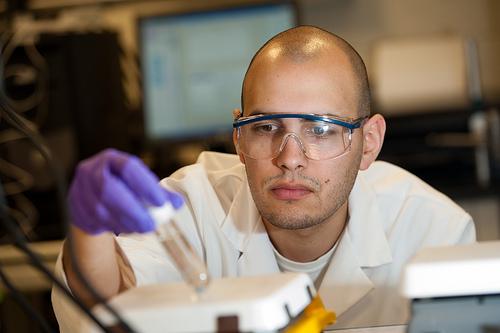A research team from the The University of Kassel in Germany has just manufactured a fully functional building material that also doubles as a solar cell. Known as the DysCrete, the most integrel components of the design include electrographic concrete as well as its fruit juice liquids.
Upon further development, the solar cell material is expected to be used for the building of facades of edifices, while also being able to create electricity as it collects sufficient amount of solar energy.
Solar cell building material marks another win for renewables
“DysCrete” concrete has a coating of several layers of organic liquid and titanium dioxide. Other components are graphite, electrolyte, and a see-thru surface. As the assembly of all components is completed, researchers will be able to manufacture a dye-sensitized solar cell, with the special concrete that assumes the function of an electrode.
DysCrete collects solar energy and turns it into electric power, a process that is made possible through the photosynthesis principle. Kassel research team also announcing that the materials utilized in the solar cell building material are 100% eco-friendly.
The developers of the DysCrete solar cell take pride in the fact that the project team uses a disciplinary researching platform known as the Bau Kunst Erfinden, or Building Art Invention. It is headed by Professor Heike Klussmann, Head of the University of Kassel’s Visual Art Studies, and Thorsten Klooster, the manager of the project.
Research funded by the Federal Ministry for Housing and Development
So far, the Building Art Invention project has already received 150,000 euros in project funding, mainly from the Federal Ministry for Housing and Development. More funds are expected to continue to pour in until the middle of 2015. Project partners are Professor Dr. Benhard Middenorf of the Building Industry and Construction Chemistry and other industry associates.
In the case of Professor Klussman, he admitted that prototypes of the concrete material have been in existence for years. “It is our goal to develop a material that can be employed in the construction industry in the future, for example for prefabricated components for building construction, façade elements, and innovative wall systems,” stated Klussmann. “At the same time, it will contribute to a sustainable and decentralized energy supply through its function as a solar cell.”
It must be known that the dye-sensitized solar cell is in itself not an idea of the University of Kassel. However, what makes the development of this particular design so unique, is the combination of solar cell technology and construction components.
Dye-sensitized solar cell utilized in design cheaper than silicon counterpart
Also known as the Grätzel Cell, the dye-sensitized solar cell is considered to be a cheap version of the traditional silicon solar cell. It was the brainchild of Michael Grätzel, a Swiss chemist, who came up with the idea by referring back to the principles of plant photosynthesis.
In order to gain the highest efficiency possible when transforming solar energy from the solar concrete, the research team headed by Professors Klussmann and Klooster is still in the process of tweaking and optimizing the wall’s coatings.
For instance, at the start of the project, the team decided to utilize currant juice while in the latter part of the project, the material experimented with other juices. Currently, the team’s target is an overall efficiency of around 2%. This figure already predicted to be profitable since manufacturing costs for dye-sensitized solar cells are greatly lower than that of the ordinary silicon type.
Photo courtesy of Oregon State University on Flickr



